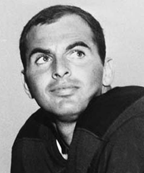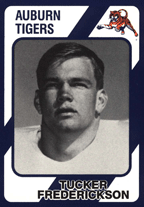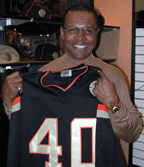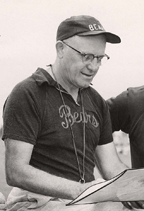|
|
|
| |
 |
|
| |
Courage is a term thrown around casually in professional sports. Rarely do we see an athlete who embodies it in words and deeds. Brian Piccolo was one of those special players. His endearing sense of humor and upbeat attitude helped him beat the odds as a player—and as a person.
As a Wake Forest undergrad, writer Mariah Stewart was exposed to the Piccolo legend for the first time in the fall of 2010. She soon discovered that separating fact from fiction isn’t always as easy as it seems. Despite being undersized and possessing just average speed, Brian played four seasons with the Chicago Bears. His lust for life also enabled him to become part of a groundbreaking social experiment, forming a friendship with Hall of Famer Gale Sayers that broke down the racial barriers that plagued the country in the 1960s. In the end, those same qualities buoyed Brian, his friends and his family as he faced the most formidable opponent of all.
 Louis Brian Piccolo was born on October 31, 1943 in Pittsfield, Massachusetts.
(Click
here for today's sports birthdays.)
He was the youngest of Joseph and Irene Piccolo’s three boys. Louis Brian Piccolo was born on October 31, 1943 in Pittsfield, Massachusetts.
(Click
here for today's sports birthdays.)
He was the youngest of Joseph and Irene Piccolo’s three boys.
By the time Brian reached his third birthday, his family had moved to Ft. Lauderdale. The warm Florida climate was better for his brother Don, who sometimes hemorrhaged from the nose and mouth.
From his earliest years, Brian was always playing sports, whether it was with Don and their oldest brother Joe, or even just tossing a ball in the air by himself. His favorite sports were baseball, football, and basketball, in that order. Brian starred in Little League and Boys' League Football, making every local all-star team along the way. He never doubted that he had the talent to be a professional athlete.
Brian attended Central Catholic High School (now known as St. Thomas Aquinas High School). His major passion was baseball, which he considered his primary sport as a teenager in the late 1950s. He also played football for Central, though his life on the gridiron was often frustrating. Brian began his varsity career as an offensive tackle. Central won just eight games in his first three seasons.
It wasn't until Brian’s senior season in 1960 that coach Jim Kurth switched him to halfback. Although he wasn't blessed with breakaway speed, Brian could block, run pass patterns, and catch the football. An intelligent and instinctive player, he made few mistakes.
Brian was also known for being a great locker room entertainer and motivator. The only negative thing his coaches could ever say about him was how much he hated practice. Brian was always the last one out of the locker room during the week—he felt that practice made him tired for when it really mattered: game time. On Saturdays, Brian was a different player. In fact, with him running the ball, Central improved to a record of 4-4 in 1960. |
|
| |
|
|
| |
During Brian’s high school career, the football star in his area was future New York Giants running back Tucker Frederickson, who went to South Broward High School and later played for Auburn. The boys from Central and South Broward were very competitive. Brian's girlfriend, Joy Murrath, would often tease him about South Broward’s superiority, which would infuriate Brian. But that rivalry had its limits. Years later, during Brian's time in the hospital in New York, Frederickson would spend a lot of time visiting him, bringing along his color TV for Brian to use.
Although he was a big-shot athlete, Brian was never too busy to spend time with Joy's sister, Carol, who was born with cerebral palsy. He always saw to it that she was part of whatever whas going on, whether it was taking her to basketball or football games, concerts, or just swimming in the pool. Brian was admirably mature and could handle her at her worst. Even when he was fighting with Joy, he would still come over to hang out with Carol. Throughout Brian's life, he kept in touch with Carol, sending her postcards of all the places he had visited. He even bought Carol her own ring when he proposed to Joy in 1964.
Upon graduating from Central, Brian was offered scholarships from two schools, Wake Forest and Wichita State. Coach Kurth convinced the Demon Deacons to recruit Brian after learning that they were already interested in a teammate, tackle Bill Salter. Salter did his part to help his teammate out by telling war stories about Brian to the freshman recruits and coaches at Wake Forest. Salter bragged that Brian had been scouted by the Pittsburgh Pirates and Chicago Cubs. He added that his friend was unstoppable on the football field and a hit with the ladies.
Once Brian settled on Wake Forest, he decided to abandon baseball for good. From that day on, he set his sights on making it into the NFL. During his freshman season in 1961, he averaged 4.2 yards per carry and scored five touchdowns. Amazingly, he didn’t register a single carry for a loss.
Brian improved on his numbers in 1962, even if Wake Forest didn’t. He led the team in rushing with 324 yards as the Demon Deacons limped home with an 0-10 mark. Brian topped the team in rushing again as a junior, this time still with 367 yards. Wake Forest's record improved only slightly to 1-9.
Brian’s senior season was headed down the same path. Before Wake Forest’s game against Maryland, the team had already suffered three losses. Up until the last two minutes of that contest, it looked like the Demon Deacons were about to lose another. Trailing 17-14, Wake Forest moved the ball to Maryland's 15-yard line. The Demon Deacon’s called Brian’s number, and he crossed the goal line for the winning touchdown. He also kicked the extra point to put the final touch on a 21-17 victory.
Weeks later, Wake Forest faced Duke. The Demon Deacons hadn't beaten the Blue Devils in 13 years. Brian ended that streak almost single-handedly. He carried the ball 36 times—breaking an ACC record—to help beat Duke, 20-7. Brian shed 15 pounds during the course of this game. Afterward, he had to be carried off the field.
The final game of Brian's college career came against North Carolina State. The Wolfpack needed to beat or tie Wake Forest to take the ACC championship. The Demon Deacons responded with a marvelous effort for a 27-13 victory that gave the conference title to Duke. Brian scored three touchdowns, while quarterback John Mackovic had scored the fourth. Mackovic would go on to an impressive coaching career, which included stints with Wake Forest, the University of Illinois, the University of Texas and the University of Arizona. He also guided the Kansas City Chiefs from 1983 to 1986. |
Tucker Frederickson, 1991 Collegiate
|
| |
|
|
| |
The win over NC State enabled the Demon Deacons to finish at 5-5, the team’s best showing in years. Brian was the key. He led the nation in rushing with 1,044 yards on 252 carries, breaking the ACC record set by Wake Forest's own Bill Barnes in 1956. He also earned the ACC scoring title, with 111 points on 17 touchdowns and nine extra points, and was named conference Player of the Year.
In the 1960s, the NFL draft was held in November. It was a big surprise when Brian was not selected. He expected to go in the first or second round. Not getting picked at all was a shock. According to Brian, there were two stories circulating at the time that hurt his stock. The first was that there was confusion on the part of some teams because a player with a similar name who went to a school similar to Wake Forest had been chosen early on in the draft. The second (and more likely) story was that teams were concerned that Brian was only 5-10 and weighed only 185 pounds.
Brian was a free agent as of December 25, when he was invited to play in the North-South All-Star Game. He had planned to marry Joy in Atlanta the following day, but the chance to showcase his skills for NFL scouts was too good to pass up. The contest proved frustrating on seveal levels. First, Brian was pulled every time the South was in scoring position. Second, the game started at 3 o’clock that afternoon, and Brian had promised Joy that he would make it to the rehearsal dinner that night. Joy and the other members of the wedding party watched on television, furious that Brian would be late. He arrived in Atlanta early on the morning of his wedding. When he saw his angry bride, all he could say with a grin across his face was, "Hell Joy, you know I hate practice."
At the wedding reception, decorating a table was a large bear carved in ice. It seemed that Brian had not been completely forgotten: Chicago coach George Halas had called and offered the newlyweds a honeymoon, as long as they would spend it in the Windy City. Three days later, Brian officially signed with the Bears. Halas called a press conference shortly after, at which many assumed the 70-year-old would announce his retirement. Instead, the press learned that Brian was the newest Bear. |
Brian Piccolo (second from left),
1964 South All-Stars wire photo |
| |
|
|
| |
Brian actually had some options. He had also received calls from the Cleveland Browns and the Baltimore Colts. Brian decided on the Bears because they had offered the most money. Chicago had also finished the previous season as the NFL’s worst rushing team, meaning Brian saw a golden opportunity to play right away. The only obstacle in his way? A draft choice by the name of Gale Sayers!
In June of 1965, Brian was selected to play in the Coach's All-America Game. Unfortunately, a hamstring kept him out of action. By July, his leg still had not fully recovered for rookie training camp. Brian was offered a job on the taxi squad, and he took it. Brian captained the offense, while aging veteran and fellow Wake Forest graduate Bill George captained the defense. They called the team the "Beavers." Brian later admitted it was the one year he really busted his tail in practice.
As Brian logged time on the taxi squad, Sayers was enjoying a breakout campaign. He set an NFL record with 22 touchdowns and was named Rooke of the Year. Fans moved to the edge of their seats every time Sayers touched the ball.
In 1966, Brian had hoped to carve out a role as a starter and share carries with Sayers. But the depth chart suddenly changed when running back Jon Arnett showed up eight days into training camp and announced he was no longer retired. Arnet has been Chicago’s second option in the rushing attack the year before. He wanted his job back. Consequently, Brian's prospects of starting were dashed. He ended up playing on special teams, running the ball from scrimmage just three times, twice against the Atlanta Falcons and once against the Green Bay Packers. Brian had hoped at times to be traded to another team where he could get more experience and playing time.
In 1967, Brian saw more action. A nice change-of-pace from Sayers, he gained 317 yards and averaged 4.1 yards per carry. It was off the field, however, where Brian made an even bigger impact. He and Sayers famously became the first white and black players to room together in the NFL, this at the height of the civil rights movement. The two quickly became close friends.
Although Brian did not get to play much in his first few years with the Bears, he had plenty to keep him busy. His first daughter, Lori, was born in 1965, followed by Traci in 1967 and Kristi in 1968.
Family, friends, and teammates all knew how much of a devoted father Brian was to his daughters. There was nothing he loved more than singing and dancing with his "princesses" while Joy prepared dinner. Neighborhood boys would knock on the door of the Piccolo home and ask if Brian could come out to play ball. He made Hollywood productions out of birthday parties, running the whole show himself and inviting the families of his coaches and teammates. |
Gale Sayers,
Black Book Partners archives |
| |
|
|
| |
On May 27, 1968, the Bears held a press conference to announce the retirement of Halas after 50 years in professional football. The new head coach was Jim Dooley. He was dealt a severe blow in the ninth game of his first season when Sayers ruptured the cartilage in his knee and tore two ligaments. Brian assisted his friend throughout his rehabilitation. He trained tirelesly with Sayers, helping him become the first player to return to football after such a massive knee injury. Sayers dreamed of rushing for 1,000 yards again after his injury, which he ultimately did.
With Sayers on the shelf, Dooley made Brian the starting halfback for the Bears. In his first game, he caught seven passes for 92 yards. In late November against the Dallas Cowboys, Brian sprained his ankle but took shots of Novocain and cortisone to dull the pain and kept playing. The following week, he registered the only 100-yard rushing performance of his career, carrying 21 times for 112 yards in 23-17 victory over the New Orleans Saints. He was a starter for a total of six games, gaining 450 yards during that stretch.
When Sayers returned to the field in 1969, Brian was demoted to a backup once again. But Dooley gave him a look at fullback after starter Ronnie Bull was injured. It was a welcome opportunity that thrilled Sayers just as much. The two shared the backfield against the Minnesota Vikings midway through the campaign.
Unfortunately, all was not right with Brian. He developed a cough early in the ’69 season. In a November loss to the Altanta Falcons, Brian left the game after scoring a 4th quarter touchdown. He had been bothered by chest pains, and his cough had not subsided. Brian's coaches and teammates knew it had to be something serious, because normally he would never take himself off the field.
Two days later, a chest X-ray was performed, and doctors spotted a malignant tumor on Brian’s left lung. He was diagnosed with embryonal cell carcinoma, an extremely rare form of cancer that develops in a fetus and remains in either the chest or testicles until it causes malignant tumors or lesions. Brian had actually had a clean X-ray just a few months earlier, but in the interim, the tumor had grown to the size of a grapefruit.
Brian was sent to the Memorial-Sloan Kettering Cancer Center in New York for surgery. There, doctors determined that the cancer had spread to his lymph nodes. They hoped that with the complete surgical excision of the tumor and long-range chemotherapy, the prognosis would be good.
Brian was discharged from the hospital on December 10, 1969. He was scheduled to return in June of 1970 for a follow-up exam. Brian quickly announced in a press conference that he intended to continue his NFL career, unless doctors advised him differently.
Although Brian was willing to give up football, he was absolutely determined to fight his cancer every step of the way. He kept an optimistic attitude and was normally in good humor about his condition. Throughout his many hospital stays, Brian often snuck out of his room to spend time with children who were sick or injured. He loved speaking to people about overcoming illness and joking around about himself and his cancer. After his first round of surgery and chemotherapy, Brian was very focused on exercising and getting back into shape, despite how much the treatment had taken out of him. |
George Halas,
Black Book Partners archives
|
| |
|
|
| |
In January of 1970, Brian was invited to play in the Astro-jet Golf Tournament held by American Airlines. In early February, Brian and Joy made their way to Arizona for the three-day event. There, Brian felt a lemon-sized lump on his chest. He and Joy decided to wait until they got home to see a doctor.
Initially, one doctor assumed the lump was simply a pulled muscle. This diagnosis did not satisfy Brian, so he got a second opinion. A biopsy of the lump confirmed it was a malignant tumor consistent with his previous cancer. Lung densities were also spotted on his left lung in the chest X-ray. Doctors felt that an intensive course of chemotherapy and possibly surgery later would be the best course of action.
In March, Brian was to be reevaluated after the chemotherapy. The lesions on his lung had grown, and the tumor on his chest had also grown and was now uncomfortable. Doctors decided that a mastectomy of his left breast and the dissection of his lymph nodes was necessary. The surgery was performed in early April. At the time, the lesions had become much worse, so Brian's left lung was also surgically removed. Doctors implanted remaining tumors with radioactive iodine seeds and ran radiation therapy on Brian.
Six weeks later, Sayers was presented the George Halas Award as the league's most courageous player for the 1969 season. In his acceptance speech, he said that Brian deserved the honor much more than he did, praising his firend‘s ability to "kid himself and his opponent—cancer." Sayers then asked everyone to pray for Brian that night. There wasn't a dry eye in the room. He later gave his trophy to Brian.
On June 4, it was determined that a tumor had invaded Brian's lower left chest wall, and the cancer had spread to his liver. During his final weeks, he remained optimistic about beating the cancer and walking out of the hospital. In a delirium brought on by shock, Brian told Joy and his friends how much better he was feeling and that he was going to make it out of there. On June 16, Brian died. The cancer had invaded his most resilient organ: his heart.
More than four decades later, the Bears still honor Brian’s memory. Each year, the team presents the Brian Piccolo Award to the rookie and veteran who best exemplify the courage, loyalty, teamwork, dedication, and sense of humor that Brian displayed on a daily basis. Brian's #41 has been retired by the Bears as well. The ACC also honors him with the Brian Piccolo Award for the league's most courageous player.
A year after Brian died, his story was immortalized in the TV movie "Brian's Song." It starred James Caan as Brian and Billy Dee Williams as Sayers. The movie won five Emmy Awards.
As testimony to Brian’s enduring spriit, the Brian Piccolo Cancer Research Fund was established in 1970. More than $8 million has been donated to finding a cure to various forms of embryonal cell carcinoma. The disease is now almost completely curable. |
Brian Piccolo, 1969 Topps
|
| |
|
|
| |

|
|
|
|

|
© Copyright 2011
Black Book Partners, LLC. All rights reserved.
The original material
appearing on JockBio.com is protected by copyright. No part of this material
may be reproduced in whole or in part, or stored in a retrieval system,
without permission of Black Book Partners, LLC. Please direct any inquiries
regarding its use to jockbio@comcast.net.
|







